|
|
| |
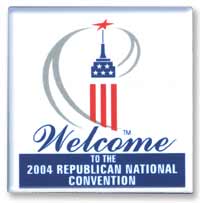
The Republicans vs. Anybody But Bush: New York City's Two Conventions (2004)Published on Senior Women Web, September 2004 View Photo Gallery Here There were two conventions in New York City at the end of the summer of 2004: the Republican Convention and the ABB (Anybody But Bush) Convention. It's anybody's guess which had the greater impact because, apart from a few streets around Madison Square Garden (MSG), the two conventions took place in different worlds. 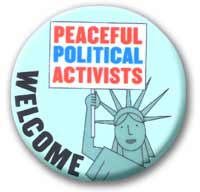 Each was a ten day gathering of the faithful, though most only went to part of either one. For the Republicans, the highlight was Bush's acceptance speech Thursday night, which filled MSG with people who came only to hear their hero; on other nights there were a lot of empty seats. For the ABBers, Sunday's march around MSG and down to Union Square was the big event. When the Republicans chose to come to NYC to tie themselves to the tragedy of September 11, they embraced a porcupine. In my 44 years of going to conventions, this is the first time that the protests at the Republican convention exceeded those at the Democratic Convention. This was partly because protest is part of the City's political culture. But it was also because the policies of the Bush administration and the invasion of Iraq mobilized and motivated people who usually prefer to take their political pot shots at their kissing cousins rather than at their natural enemies. Bush fulfilled his campaign pledge to be "a uniter"; he brought them all together to protest his presidency. I traveled between the two conventions every day, but without a few clones I could only see snippets of each. For the most part my press credentials got me in, around and through to whatever I wanted to see, though there were a few moments when nothing worked. The Republican ConventionThis was the first time the Republicans met in Convention in this quintessentially Democratic city. New York City occasionally elects Republican mayors when the Dem family squabbles become lethal, but the city as a whole has voted Democratic since the party was founded. The Democratic Party has changed over time, and so has New York City but it is still Democratic culturally and politically. The City closed down for the Republicans. The Javits Convention Center, which is normally bustling with business, was shut for two weeks, except for about 250 people attending meetings of the Republican convention committees the week before. While some businesses prospered (e.g., hotels), others suffered (e.g., taxis and stores within the security zone). Many locals who work in Manhattan took the week off if they could. Of course anyone associated with law enforcement did the opposite; students in the Police Academy got lots of on-the-job training. Close to 8,000 volunteers came to be part of the scene even if it meant standing for long hours handing out booklets or giving directions. The Platform CommitteeThe Platform Committee is just one of four Convention Committees; since 1964 these have been composed of one man and one woman from each state or territory. The Democrats scatter their meetings around the country in the months before their convention; the Republicans concentrate theirs the week before in the convention city. These committee meetings have often been a window into the internal conflicts of the party, which has attracted a lot of press attention. The press loves conflict; the parties don't. 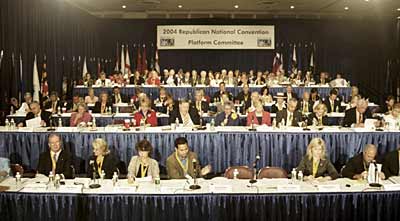
To avoid the inevitable appearance of divisiveness created by democratic debate of the issues, the Republicans maneuver to keep their squabbles less visible. This year there were no hearings and the Platform subcommittees met only on Wednesday morning. While there was some effort at these to move some planks in a more conservative direction, the few votes went the way the Bush campaign representative signaled. I asked Phyllis Schlafly, a perennial observer of Platform Committee meetings, if any of her core issues were threatened. "Immigration," she said. "We're having a little problem with that one." "And abortion?" I asked. "Oh no!" She looked surprised that I should even bring it up. "That's a lock." Ann Stone, the conservative founder of Republicans for Choice, and also a Platform perennial, agreed. She said that this year none of the pro-choice groups even polled the Platform Committee to find someone willing to introduce language saying those holding different views were still welcome in the party. Stone said her group was working with the Log Cabin Republicans this year, along with a third group that calls itself the Republican Youth Majority. What they have in common is that their party has shut the door in their face. The LCRs are a gay group who have been futilely begging for crumbs of recognition from the Republican Party for decades, even as the party shoves them further away. They claimed about 50 delegates to this convention, while stating that the "Republican Party Platform is an outrageous insult to all of us and our families." LCRs just can't cut the umbilical cord. The fact that they held their "Big Tent" event for the Convention during the Big March on Sunday shows how little connection they feel to the ABBers. The Bush campaign likes surprises even less than divisiveness. When the full Platform Committee met that night and on Thursday, proposed amendments had to be made in writing; the unapproved disappeared before they could be discussed. Jane Hartley of Oregon proposed language to give "stay-at-home mothers" tax credits for the child care that they provide to their own children; it was quietly withdrawn without a word. Although the Committee meetings are public their time and place were not on the convention webpage. It took several phone calls to locate them. Getting in required not only press credentials and going through a bag search and metal detector, but leaving a photo ID at the gate. There were about 50 guests (e.g. not press, delegates or staff), all pre-screened. I watched the National Committeeman from Utah wait for a staffmember to come and OK his entrance because he hadn't called ahead. Getting In and AroundThe area around MSG looked like an armed camp; it was an armed camp. Jersey barriers and trucks blocked streets; steel fences kept people on the sidewalks, or off of them as the police dictated. Officers in black uniforms, some with dogs on leashes, were everywhere -- at least half a dozen in front of each convention hotel. Police controlled the flow of pedestrians at the crosswalks with orange plastic fences that they moved back and forth on cue. Public buses were rerouted several blocks around MSG. The subways underneath weren't closed, but riders had to go up, down, and around to find a way out, or in. 
Yet, there were openings. Penn Central Railway Station, on the same block as MSG, was not closed; one could walk from 32nd street across Seventh Avenue and down the stairs into the station; you just couldn't turn on to the sidewalk next to the street without proper credentials. And, unlike Boston, trash cans were left on the city streets. The Farley Building, once NYC's main post office, was turned into a gigantic press room, with curtains marking the various press areas on three levels. The RNCC built a bridge across Eighth Avenue from the Farley Building to MSG for the press to come and go. That was the only entrance press could use to get into the convention itself. The press route into the Farley Building was halfway toward Ninth Avenue, past numerous police who checked credentials before admitting anyone to the fenced pathway in the street. At the press entrance I spotted several different uniforms. The Fire Department was "on call" just in case. They were waiting there, I was told, rather than at their station, so they wouldn't have to go through security if they had to respond to an alarm. Two fire trucks were parked inside the security zone. Customs agents hung out while their dogs worked the crowd. Volunteers in red shirts directed the flow of press people, many carrying lots of gear, to different lines in the search tent. At the metal detectors, searchers from the Transportation Security Administration (TSA), confiscated a variety of objects. Produce was prohibited on the grounds that it could become projectiles. So were bottles of anything that one could not drink. Unlike the Democratic Convention, potables were not prohibited, but one had to take a sip in front of a searcher to show that it wasn't a dangerous substance. "Good Brooklyn tap water," I told the guard as I gurgled. "Drawn only this morning." Eech, she said. Aerosol cans, containing hairspray or even just compressed air (used by photographers), were also confiscated. I heard there was a list of 22 prohibited items, but no one but the searchers seemed to know what they were. My bag of pins and buttons, each with a sharp point, was never noted. On Tuesday I brought in some posters, rolled up inside my backpack; on Thursday their equivalents were confiscated. Once inside I found that the rule against fruit did not apply to the caterers. Apples, oranges, peaches and plums were available at the restaurant, in the various press rooms that fed their own staff, and in the Bell South Media lounge, which fed the rest of us. Hah, I thought, another stupid security rule. I thought too soon. When time came to go to MSG I found still another bag search and metal detector for press to go through before ascending the bridge. There I was caught with dangerous objects in my backpack: one apple and one peach. My camera lenses, which are much heavier but not as round, passed without a peep. Security elsewhere was not this cumbersome, but there was still security. The "Grand Old Marketplace" where vendors paid $2,500 each for about 60 spaces to sell Republican-related tschotschkes, was on the second floor of the Hilton Hotel. Something else must have been up there as well because guards wouldn't let anyone up who didn't have proper ID and pass a security check. Pity the poor self-employed vendors who thought their wares were available to anyone with money. Less important hotels were more readily accessible. In several of these the RNCC had its own vendors selling its own tschotschkes in each lobby. Business was booming, one of them told me. In Pursuit of Republican WomenI scanned the 32-page Republican Master Events Calendar (MEC) for events specifically for, by or about women. I found several, but the MEC only listed names of locations, not addresses. I phoned the convention HQ switchboard to ask where to find exact addresses, only to reach a very irate young woman who told me that wasn't her job. She transferred me to a variety of connections (host committee, communications office) all of which were answered by tape recorders). Getting into the convention events clearly required a behind the scenes staff or inside knowledge. Fortunately, www.rncnotwelcom.org had obtained the same list, and posted it on its webpage along with some of the addresses needed to get there. Monday morning I found that the Host Committee had a concierge service for the press in the Farley Building, run by staff from the major hotels. They recognized locations that were unknown to me and helped me to find my way. Getting in was another matter. By the time I found this service, I had already missed the "Salute to Women Members of Congress" luncheon in the JP Morgan Chase Building (wherever that was), but there was still time to go to the Black Republican Women International Minority Forum and Reception at The Helmsley Hotel. But which Helmsley Hotel, I was asked when I requested directions. There are several, and since the MEC contained no contact information for the event host, there was no one to phone to find out. At 4:00 the National Federation of Republican Women held a Regent's Reception at the Lotos Club. The NFRW is the largest of the women's partisan organizations, whose history I had summarized in my book, A Room At A Time. The concierge service knew the club's address. Forty-five minutes later I walked up the stairs of an elegant private club on Manhattan's upper east side only to be stopped at the top by a formidable Republican dowager. You're with the press, she inquired, eyeing my tags. "I'm so sorry, but the Lotos Club doesn't permit press on the premises." Next I went to the Women's National Republican Club, founded after the 1920 election to provide a meeting place for Republican women. It owns its own building in Rockefeller Center. The MEC said there was a reception going on there, but the man behind the desk said there wasn't. Tuesday started out the same, but got better. The MEC listed an 8:00 breakfast by the Women's Campaign Fund, which funds pro-choice women in both parties, at the WNRC. Since the desk man had told me it wasn't on his schedule, I skipped it. I did get into the "Tribute to Laura Bush" luncheon, which required press credentials and a Secret Service screening, but no bag check or metal detector. Inside was a large camera riser, 75 feet from the podium, overflowing with cameras. The rest of the press were roped into a small area around and mostly in back of the camera riser. At the Laura Bush tribute at the 2000 convention the press were allowed to eat and mingle with paying guests, as well as get close enough to shoot a couple photographs with ordinary cameras. This time we couldn't see, we couldn't sit, we couldn't shoot, and we certainly couldn't eat. I left after ten minutes. At 3:00 I was back at the WNRC, which was "Celebrating Leading Women of the Republican Party", the only event the desk man had on his schedule. The honorees were the four women (out of 28) Republican governors, plus Mrs. Giuliani, who was listed first. Proving once again that being a political wife, even the young third wife of a former politician who never did a political thing herself, qualifies one to be a Leading Party Woman. It's also a way to get her husband to come. I did have a little trouble getting in; since I had not been pre-approved I was kept waiting twenty minutes before being questioned and allowed to pass. When asked for my card, I handed over my book flyer and told the woman assigned to vet me that I had done some of my research at the WNRC. "It's a history of Republican women," I said, half truthfully. Next stop was a small restaurant reception by the Republican Women's Task Force (RWTF) of the National Women's Political Caucus. The NWPC was founded in 1971 as a bipartisan organization with a feminist perspective. It quickly set up Task Forces to lobby for women in both parties. However, Republicans were always a minority in the NWPC. As feminism became identified with the Democratic Party, the RWTF was denounced as disloyal to the GOP. The RWTF's role as the feminist voice in the Republican Party faded during the Reagan era and was replaced by the pro-choice Republicans (who would never publicly call themselves feminists). I was glad to see that the RWTF was back and happy that I had no trouble getting in. After chatting with the real Republican feminists for a while I went to a reception sponsored by the Republican Majority for Choice at the Sky Club -- an elegant, spacious private club for executives on the 56th floor of the Met Life building. While the anarchists who tied up the city streets were cooling their heels in a holding cell on Pier 57, along with some innocent bystanders and mere observers, I spent two hours living like a rich Republican. The RMC is one current incarnation of what used to be known as the liberal wing of the Republican party, with roots deep in Teddy Roosevelt's progressives. After conservatives succeeded in stigmatizing the word "liberal" they called themselves Moderates. Most of the 650 guests bought $500 tickets to "Celebrate Their Moderate Voice" by honoring 40 elected officials who believe in "individual rights and privacy, the real Republican values." Co-host Libby Pataki (wife of New York's governor) said "I'm so proud of my party -- the party of inclusion," while the other co-host, NYC Mayor Michael Bloomberg, said he was there because "I care about my daughters." Unlike Ann Stone's group, these "moderates" are still inside the Party, but are marginalized. Organizers said that this event raised one million dollars to support a woman's right to choose. The RMC organized "Women for Arnold (Schwarzenegger)" during the California recall election and "Women for Arlen (Specter)" during the Pennsylvania Republican primary. Recently they endorsed Cong. Jim Kolbe, running for an 11th term from Arizona. Kolbe was "outed" in 1995, but managed to stay in Congress from his otherwise conservative district. Other Republican Members of Congress who have been "outed" or even rumored to be gay have not run for re-election.
My pursuit of Republican women ended with the WISH List breakfast on Wednesday, where I joined 350 others who came to honor Congresswomen Nancy Johnson (CT) and Sue Kelly (NY). Founded by Candy Straight and "a forward-thinking group of Republicans" in 1992, the WISH List — Women in the Senate and House — is a PAC that funds the campaigns of pro-choice Republican women at all levels. After Straight became the co-chair of the New Jersey Republican Party, Pat Carpenter took her place as President of the WISH List. She told me that the 5,000 people who paid the $100 membership fee are concentrated in the northeast, but there are large numbers in northern California and Arizona. ... and other RepublicansUnlike the Democrats, the Republicans don't hold interest group meetings. They hold receptions. Some are fundraisers, some by invitation only. The MEC had long lists of events hosted by corporations, interest groups and law firms honoring various elected officials and state delegations as well as their own adherents. A lot of corporations paid big bucks to sponsor these parties; some individuals paid big bucks to get in. The most feted delegation of all was Alabama. Why? Alabama Senator Richard Shelby and Rep. Spencer Bachus hold key positions on the Senate Banking and House Financial Services Committees. New York is the financal center of the country with a lot of corporations who want to cozy up to these important men and their friends. I didn't go to any of the Alabama parties, but I did sample a couple others. After the Sunday march several thousand protestors went to the Great Lawn in Central Park to relax, largely because the City had told protest leaders that they couldn't congregate there. I went to the Jewish reception at the Chelsea Piers, where the free food was much better than that at the media party the night before. It was sponsored by The American Israel Public Affairs Committee (AIPAC), the Republican Jewish Coalition (RJC) and United Jewish Communities (UJC). After signing in, showing all my credentials plus a photo ID, and going through the metal detector and bag search, I heard NYC Mayor Michael Bloomberg tell the crowd that he supported George Bush because he "stands up for Israel" just as he "stands up for America" which, he added, is the same the thing. However, it was gentile Rudy Giuliani who got the standing ovation and cheers from the crowd, many of whom want him to run for President in 2008. Bush-Cheney campaign manager Ken Mehlman put his foot in his mouth when he looked over the audience of several hundred and told them that he hadn't known that there were that many Jewish Republicans in New York City. He obviously hasn't read the election returns from Brooklyn in many, many years. On Tuesday I tried to find the National Black Republican Leadership Council, but no location was listed in the MEC, and no one I spoke to knew where its event was being held. I asked Phyllis Schlafly if she was holding her usual convention revival when I saw her at the Platform Committee meeting. I've been to several and find them entertaining and educational. I was closed out of the one in Philadelphia, and she told me I couldn't get into this year's "Life of the Party" luncheon either. Officially sponsored by her Republican National Committee for Life, it honored eight Members of Congress for their pro-life support. Apart from Schlafly, the far right was staying out of sight, perhaps to avoid arousing the natives. The Christian Coalition, which hosted a standing-room-only rally for 3,000 at the last Republican convention, was nowhere to be seen. The Bush-Cheney campaign held a "Faith, Family and Freedom" rally for Christian conservatives on Tuesday afternoon, but it was by invitation only and closed to the press. Pro-lifers included counter demonstrations at pro-choice events on their list of 22 things to do in NYC, but their numbers were small. Only 37 greeted the pro-choice march as it entered Manhattan after marching across the Brooklyn Bridge on August 28, and I didn't see any outside of the RMC reception or the WISH list breakfast (which were on their to-do list). The National Federation of Republican Assemblies calls itself the Republican wing of the Republican party. It's "committed to conservative Republicans and works to prevent liberal Republicans from receiving the GOP nomination throughout the nation." At its hospitality suite in a hotel only a block from Madison Square Garden NFRA held daily prayer meetings, several screenings of the movie "George W. Bush: Faith in the White House," book signings and tributes to Ronald Reagan. It was open to anyone, no questions asked. Policy panels are the exception at Republican Conventions, but there were some. The American Jewish Committee held five on ethnic themes (Jews and Indians, Koreans, Latinos, Turks and the Crisis in Darfur). I went to the one on Anti-Americanism, a cozy affair where I didn't even have to sign in, let alone go through a bag search. 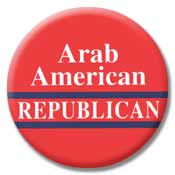 The Arab American Institute sponsored a discussion of the Patriot Act at a major NYC law firm, one of whose partners is a founder. Some of his wealthy mid-east clients have had their bank accounts attached or closed as a result of the Patriot Act and they aren't happy about it. Most of the other panelists didn't like major portions of that Act either. Former Georgia Congressman Robert Barr was particularly eloquent in his denunciation of the Patriot Act as a violation of the right to privacy. He said he was one of the few Members of Congress who actually read it. Inside Madison Square GardenDespite going through two bag searches and metal detectors along with multiple ID checks before entering MSG, people still smuggled in unapproved messages. The conservative Family Research Council put fortune cookies on every writing press desk. The "fortune" inside said "Save the Constitution! Impeach an Activist Judge." Perhaps the FRC doesn't know that most federal judges have been appointed by conservative Republican Presidents. 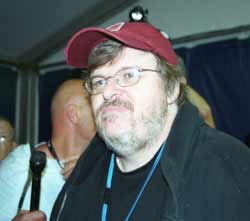
Anti-war activists wore shirts, slips and banners into MSG three of the four nights; they were thrown out when they pulled off outer layers of clothing to show their slogans underneath. Short of requiring everyone entering to do a strip, there's no way the TSA could have prevented their entry. Film maker Michael Moore was too big to smuggle in. He walked in wearing press credentials. I found him holding a mini press conference in the hallway Monday evening. When I asked whose credentials he was wearing he said U.S.A. Today had hired him to write a daily column on the Republican Convention, as it had hired a conservative to write about the Democrats. "This is a Republican town," he said disingenuously to the people who surrounded him in the hallway. "It's full of very wealthy people who love the Republican Party." Did Sen. John McCain know he was in the stands that night when he referred in his speech to a "disingenuous film maker?" McCain's speech was part of the Republican effort to soften its image. Both parties try on each other's clothes for the public at their conventions. Moderation and diversity were the Democratic themes that the Republicans put out for public view. The hard right got the Platform; the "moderates" got the podium. However, those moderates are political descendants of Barry Goldwater, not Nelson Rockefeller. Compared to today's social conservatives, Goldwater, who supported a woman's right to choose abortion and the Equal Rights Amendment, was a moderate. The diversity claim came from "an estimated 70 percent increase among minority delegates" leading to "the most diverse group of delegates in party history," according to an RNC press release. "In 2004, minorities make up 17 percent of total delegates and women make up 44 percent," it said. The RNC bragged that in 12 states "women represent 50 percent of their delegates." This claim was based on an average of the surveys done by several news organizations, not an absolute count. I asked a number of sources at the RNC and at the convention to find out the absolute number of women delegates, but everyone claimed not to know. The Democrats know exactly how many women were credentialed as delegates; the Republicans could easily find out by counting the official "roll," or just asking the state chairs. The Republicans could know the number of black delegates if they asked the Joint Center for Political Studies which counted 167, or 6.7 percent of the total. The last time there was anything close to that percentage of black delegates at a Republican Convention was in 1912. The GOP calculation also lumped the "nearly 5,000" delegates and alternates together, even though the press release said "delegates." The Republican convention has fewer delegates and more alternates than do the Democrats. Women have always occupied more of the alternate seats than those of the delegates. This may also be true of minorities. The CBS/NYT survey of 1,200 of the 2,509 delegates found that 43 percent were women, and 85 percent were white. Among minorities, six percent were black, two percent Asian, and seven percent were Hispanic. 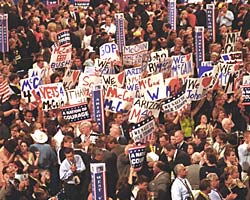
The Republicans were less lavish with their signs than the Democrats. Rather than fields and forests of printed signs waving from the audience, there were little clusters of hand painted ones. These gave the impression of grass roots action, even though they were painted and passed out by convention staff. There were printed signs, but far fewer than in Boston, and few with the speakers' names. "A Nation of Courage," "A Safer World" and "Salute our Troops" was all they said. On Thursday a few "Four More Years" were passed out to wave while Bush was speaking. The second of the two podiums didn't go up until Thursday, and only President Bush spoke from it. Stretching out into the middle of MSG the sight lines were better from seats that could barely see the podium used by rest of the convention speakers and the Presidential seal on which Bush stood was visually impressive. While Bush was giving his acceptance speech, the audience in back of him twice began to chant loudly "Four More Years." I saw guards remove one person from the floor. I later learned that two anti-war protestors had removed outer layers of clothing to show anti-war messages underneath. One was June Brashares, wearing an alternate badge, who stood on her chair and yelled out "Bush Lied" while unfurling a banner. After she was tackled and hustled off of the floor, Jodie Evans of CodePink, took off her dress to reveal a pink slip that said "Fire Bush! Women say bring the troops home now!" Bush would probably have never known what happened if the crowd around the protestors had not chanted so loudly. It was the chants, not the protestors, that stopped his speech while the latter were dragged out of the hall.
The ABB Convention 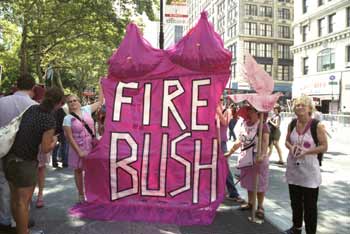
Although there was speculation beforehand that street action in New York 2004 would be the sequel to Chicago 1968, both police and protestors have grown too sophisticated for that to happen. Protest, even civil disobedience, has become ritualized and routinized. Police are too well trained to act out their animosity in front of cameras. Police policy is to contain protestors with artificial barriers and overwhelming force, but the NYPD will sometimes stop traffic for unpermitted marches, or unpermitted routes, rather than create a confrontation. New York City mobilized its 37,000 police for the two conventions, even as its Mayor said that peaceful political activists were welcome. Only in numbers did New York 2004 top Chicago 1968, where street battles and police riots led to 589 arrests. While the 1,806 New York arrests were three times higher, violence was minimal and injuries were few. Preparations for the ABB convention were almost as extensive as those for the Republicans, but less centralized. Police negotiated permits with numerous groups for marches, vigils and other legal actions all over the City, not just in the official protest zone on Eighth Avenue, one block below MSG. Virtually all groups that sought permits, got them. Trainings for direct action and civil disobedience were held at several churches. The National Lawyer's Guild and the New York Civil Liberties Union held workshops on what to do if arrested and distributed a pocket publication on "What To Do if You're Stopped By the Police: RNC edition." They also trained legal observers and video witnesses to record the actions of the police. There were numerous ABB centers. St. Marks Episcopal Church in the East Village was "a space for general health services and chemical weapons decontamination" where one could also find food and housing. A.N.S.W.E.R.'s Resistance Center was in the West Village. The Independent Media Center published a "People's Guide to the Republican National Convention" along with a map and legend to where things were expected to happen . The NYCLU opened a legal advice storefront near the MSG. Books not Bombs had several convergence centers where youth could make banners and puppets, speak out, or just hang out.
The NYPD agreed with United for Peace and Justice that the best place for a rally after the big march was Central Park, but both were overruled by the City administration. Because the courts would not order the City to let protestors use Central Park and UfPJ rejected the proffered space along a stretch of roadway on the west side, there was a small rally in Union Square before the march, but nothing afterwards. The march came off with few disruptions and few arrests; even the counterprotestors were mostly unmolested. There was a striking lack of a feminist presence in this march. CodePink was certainly there for women; but women walking for peace is as traditional as the color pink. The pro-choicers had their own march and rally the day before and NY-NOW had its own rally in Central Park later in the week. Feminist signs and slogans were noticeable by their absence from the main march on Sunday. 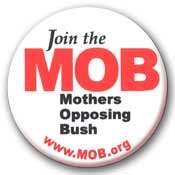 Union Square, 20 blocks from MSG, was protest central all week, as it has been for over a century of NYC history. Every day there were different displays, mostly objecting to the war on Iraq. To illustrate the human costs of war the American Friends Service Committee exhibited 978 pairs of combat boots, representing each American soldier killed since the Iraq invasion, along with a scattering of civilian shoes for the ten to fifteen thousand Iraqis who also died. A distraught father sat in front of them with a photo of his dead Marine Corps son. Vets for Peace and Military Families Speak Out also vigiled on the Square. The Iraq Memorial wall, created by two women from New Jersey, listed the Iraqi Civilian Casualties whose names could be determined. There were marches every day for a week. On Friday, almost 300 people (175 adults, 102 babies and children) organized by Mothers Opposed to Bush (MOB) marched across the pedestrian walkway in the middle of the Brooklyn Bridge. On Saturday 20,000 pro-choice protestors, their way cleared by a line of female cops, crossed the Bridge to a rally on Broadway next to City Hall Park (permanently closed for security). 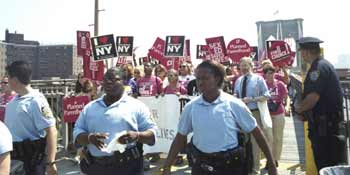
On Monday, Still We Rise led a couple thousand people concerned with issues of the desperate and dispossessed (HIV/AIDS, homelessness) from Union Square to the official protest zone, while March for Our Lives came from the United Nations. Labor rallied on Wednesday and artists paraded in Harlem on Thursday. Tuesday was anarchists day, as the A31 coalition sent small groups all over the City to tie up traffic by committing civil disobedience. That evening they converged on Herald Square, two blocks from MSG, where they blocked traffic and taunted police. The police, who usually try to avoid political arrests for the simple reason that it costs so much to process someone through the system, rounded them up rapidly and sent roughly 1200 persons, not all of them protestors, to stew on buses before being dumped in a former bus terminal being used as a holding cell. When 470 were kept in custody more than the 24 hours the New York Court of Appeals allows for processing, a state judge ordered them released and said he might fine the City $1000 for each person still held after the deadline. There were two other days with over 250 arrests. On Friday, 5,000 bicyclists rode through Manhattan to protest the coming of the Republicans. Between one and two hundred were arrested for blocking the streets and running red lights. Sunday was the second day, but there were few arrests at the march. Most of the 253 arrested were demonstrating at delegate welcoming parties or in front of delegate hotels that evening after the march ended. Of the 1,806 persons arrested for convention activities 82 percent (1,480) were charged with disorderly conduct, which is a minor offense, not a crime, in New York law. The normal procedure for such offenses is to issue a Desk Appearance Ticket ordering the person to appear at a later time for processing. Less than ten percent of all arrests resulted in convictions. Initially charges against 227 persons who had been arrested at a War Resisters League demonstration near the former World Trade Center were dismissed when videotape showed that they had done nothing unlawful. As the rest of the cases approached trial, videotape taken by the I-witness Video project, news reporters, some private parties and even the police showed that most of the rest had not violated any statute. Within seven months of their arrest, only 162 defendants had been convicted or pled guilty; 90 percent of the rest had their cases dismissed. Statistics tell something about who went to jail for what. Of the 18 percent not charged with disorderly conduct, three were juveniles, 282 were charged with misdemeanors, and 56 with felonies. The latter included those arrested for protesting inside MSG. Of the 1,735 arrestees who identified themselves, only 600 lived in New York State. Nonetheless, only a fraction of the people who came to New York for the ABB convention were arrested for anything. Most came to protest peacefully, and otherwise do their own thing. Things to do happened all over the City. The Immigrant Solidarity Network held a "speak out on the issues" on Friday. The Green Party organized an Ecology Festival in Washington Square Park on Saturday. Historians Against the War held a town hall meeting and the Yippies hosted a tea party. There were film screenings, poetry readings, concerts, and art exhibits; prayer vigils and parties; religious services and irreverent dramas; bike rides and conferences. No one could do it all, or even find it all. Peaceful protest was the dominant theme. Altercations were largely verbal. Protestors and counterprotestors marched in and around each other's events, or battled with their signs. Jeremiah Baldwin drove from North Carolina to preach for Jesus and Bush. He said he had a lot of verbal confrontations but no one spit on or assaulted him or did anything but argue. His only problem was with the police, who told him to keep moving or go to jail. Communists for Kerry set up shop in Union Square on Saturday and joined the big march on Sunday. They were sufficiently subtle in their satire that most folks didn't know which side they were on (hint: it isn't Kerry's). The impersonators of Lenin, Castro and Che marched without incident under banners declaring "beat weak liberalism with strong communism." At the end of the march they met their counterparts, Billionaires for Bush, which describes itself as a "grassroots network of corporate lobbyists, decadent heiresses, Halliburton CEOs" with over 60 chapters nationwide. The BBs did their thing at both conventions in 2000. This year they welcomed Republican delegates at theater parties on Sunday, vigiled for Corporate Welfare on Monday, "flashmobbed" on Tuesday, taunted the unemployed on Wednesday before going to their coronation ball, and rested on Thursday. Protest Warrior wasn't subtle. Its slogan is "fighting the left, doing it right." Everyone knew which side they were on from their satirical signs. PW makes it a point to infiltrate anti-war marches wherever they happen. About 120 of them fed into the Sunday march from one of the side streets. The police broke them up into smaller groups. These marched peacefully until the "anarchist teenagers" as one long-haired protest warrior described them, began to harass them. Then the police pushed the PWs outside the metal fences that lined the route -- for their own protection. Protest warriors were rewarded with guest passes to MSG events that were passed out at the NFRA hospitality suite. 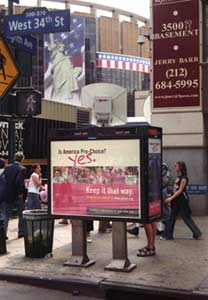
Some protests were low-key, very low-key. Planned Parenthood paid for advertisements on street corners near MSG. Although NYC is a pro-choice town, the pro-choice people kept to themselves and their own events. I saw exactly one woman with a pro-choice sign outside of a convention hotel. The yellow shirted Falun Gong, on the other hand, handed out their leaflets on street corners, outside and even inside of the hotels. They didn't make the media, but probably reached more people who were otherwise unfamiliar with their cause than any of the direct actions. Overall the ABB convention was a success, despite too many unplanned arrests and some difficulties in getting released. Hundreds of thousands of people voted with their feet, traded information, learned a few things, had a good time, and left ready to vote at the polls. New York City will be cleaning up after and paying for its two conflicting conventions for months, maybe years, but the participants of both went home happy, and security personnel made a lot of overtime. View Photo Gallery Here To Top Books by Jo | What's New | About Jo | Photos | Political Buttons Home | Search | Links | Contact Jo | Articles by Jo
|